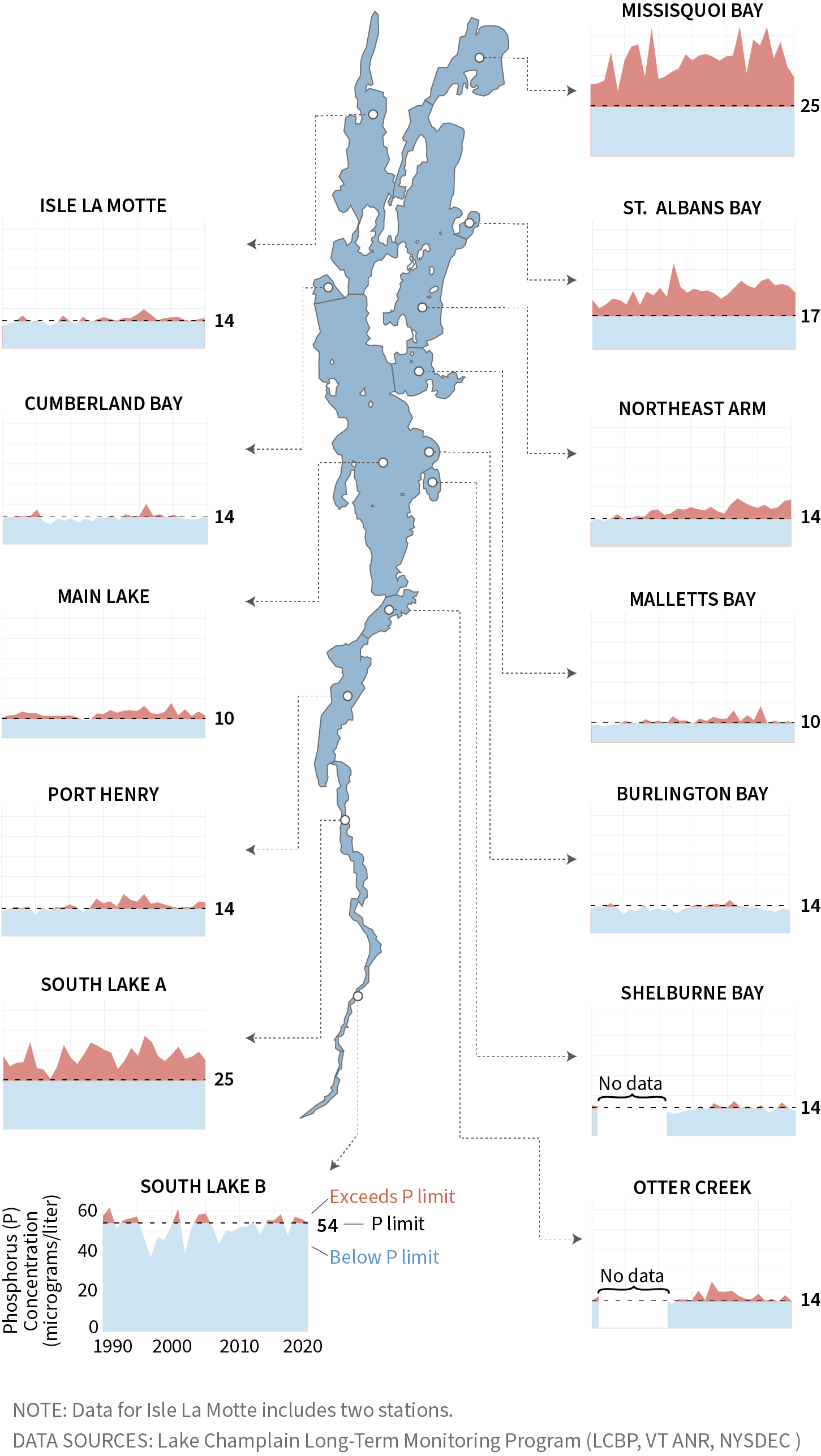Nutrient Pollution

Nutrients are as critical to a lake ecosystem as they are to terrestrial ecosystems. Aquatic plants and algae require nitrogen, phosphorus, and a suite of micronutrients. When there is too much of a particular nutrient, certain plants or algae can dominate a system.
Phosphorus is one of the primary water quality challenges in Lake Champlain. Found in lawn fertilizers, manure, as well as in human and other animal waste, phosphorus causes algal blooms and excessive aquatic plant growth when present in high concentrations. This plant material and the water quality problems that occur when it decomposes can harm fish and other organisms and limit the use and enjoyment of the Lake.
Some forms of phosphorus fuel cyanobacteria more easily than others. For example, phosphorus can be bound to soil particles that erode from streambanks. When in this “particulate” form, the phosphorus is inaccessible to cyanobacteria; it may take months or years for this phosphorus to be released in the Lake in a form that can be used for cyanobacteria growth. In contrast, dissolved forms of phosphorus in fertilizer and wastewater treatment effluent are more readily available for cyanobacteria growth. Targeted efforts to reduce phosphorus loading to Lake Champlain should address all forms of phosphorus.
Phosphorus levels are above established targets in several parts of Lake Champlain, including Missisquoi Bay, St. Albans Bay, and the South Lake, where algal conditions are a nuisance for much of the year. Cyanobacteria (blue-green algae) often pose public health threats during the summer in these shallow parts of the Lake. In an effort to address the problem, Vermont and Québec signed an agreement for reducing phosphorus to Missisquoi Bay that lays out a collaborative approach to the issue.
Phosphorus Reduction Progress
Many lake segments have phosphorus concentrations that are often near or below targeted limits. However, phosphorus concentrations in Lake Champlain’s shallow bays are often above these limits and generally have not decreased in recent decades.
From 1990 to 2017, most segments did not show long-term trends in phosphorus concentration, though the Northeast Arm showed an increasing trend over this time period. Annual average concentrations often have been near or below targeted limits since 1990 in the Main Lake, Isle La Motte segment, Cumberland Bay, Port Henry, South Lake B segment, Malletts Bay, Burlington Bay, and Shelburne Bay, which make up approximately 82% of the Lake’s volume.
Phosphorus concentrations above targeted limits have been observed in the shallow waters of Missisquoi and St. Albans Bays, the Northeast Arm, and the South Lake A segment. Some of these areas have high phosphorus loads from their contributing sub-watersheds. Also, because there is less water to dilute incoming nutrients, shallow bays are more susceptible to problems associated with excess phosphorus than the deeper bays and Main Lake. Shallow bays are also more affected by phosphorus moving up the water column from sediment at the bottom of the Lake.
However, nonpoint source loads still significantly exceed targets in at least four of the five major lake segments. With the exception of Shelburne Bay and a portion of the New York share of the South Lake watershed (South Lake A), all smaller watershed segments exceeded target levels. Conversion of agricultural and forest land to developed land, inadequate implementation of Best Management Practices (BMPs), and streambank erosion continue to slow progress in this area.
More about phosphorus
For the most recent information about phosphorus, please visit the “Phosphorus” page of our State of the Lake website
To learn about actions taken to address nonpoint phosphorus pollution, please visit the “Clean Water Goal” in The Lake Champlain Management Plan Opportunities for Action.
For additional maps and information, please visit the Lake Champlain Basin Atlas.
Nonpoint Source Pollution Fact Sheet
